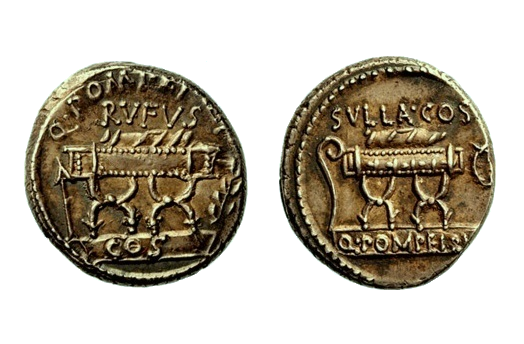
about ancient nomos
Ancient Nomos Art is a museum of galleries exhibiting ancient coins and ancient mint maps. The coin gallery displays the diverse art and history of hand-crafted ancient Greek, Roman, Byzantine, Persian and Medieval coinage. The ancient mints mapping gallery features Greek, Roman, Byzantine, Asia Minor and Medieval mint city regions and territories. Visitor's are welcome to explore, study and enjoy Ancient Nomos Art.

Roman Republic – 54 BC
Q. Pompeius Rufus
From Ancient Galleries

Obverse: Curule chair with seat cushion, flanked by an arrow on left and palm branch on right.
Reverse: Curule chair with seat cushion, flanked by an arrow on left and laurel branch on right.
LEGEND
Obv: Q • POMPEI • Q • F / RVFVS. Side view of a Curule chair with seat cushion above. Chair is flanked by an arrow to the left and a laurel branch to the right; COS below on a raised tablet. Rev: SVLLA • COS. Side view of a Curule chair with seat cushion above. Chair is flanked by a lituus to the left and a wreath to the right; Q • POMPEI • RVF on a raised tablet below.
The above Republican Roman silver denarius was issued by the moneyor, Quintus Pompeius Rufus, in 54 BC to commemorate his grandparents and his membership as a Roman tribune. Pompeius Rufus, (known as the younger) was the grandson of the dictator Lucius Cornelius Sulla and Q. Pompeius Rufus, Sulla’s consular colleague in 88 BC. This coin was issued in part to honor their past consulships, military and political careers. Notably, Lucuis Sulla (the senior), successfully suppressed the revolting Persian’s under the leadership of Mithradates VI of Pontus. This military campaign became the first successful Mithradatic War. Later, in 83 BC, Sulla returned to Italy as a renegade Roman, but his charisma, loyalty and intelligence won the support of influential Senators and many Roman citizens. Eventually Sulla gained enough power to be considered a dictator. He used his new found political influence to reform the Roman constitution and attempt balancing the rights of the Senate oligarchy with those of the populist Tribunes. The above coin celebrates the implements that objectified Roman Senatorial powers. The combined obverse and reverse image included the arrow, wreath, palm branch, lituus and curule chair (sella curulis). These were highly venerated symbolic objects, used by the most important Romans including; Magistri Equitum, Consuls, Praetors, Curule Aediles and Censors. According to Livy, the curule chair originated in Etruria and has been depicted on surviving Etruscan monuments to identify Magistrates. One of the earliest recorded examples of the curule chair was in 494 BC when Manius Valerius Maximus was honored in the Circus Maximus in a chair. The curule chair resembles a kind of folding camp stool with curved crooked legs. They were often ornamented in ivory and overlaid with gilding (Ep. I. vi. 54). There are at least three symbolic meanings associated with the chair on this coin. First, the double sided chair images were issued as a propaganda message to republican Rome, with the intention to glorify the current position of grandson, Q. Pompeius Rufus. Second, the chairs reflect symbolically the official Consul’s expectation of carrying out the Roman duties and tasks in an efficient and timely manner associated with the public functions. Thirdly, the folding chair was a transportable object that could easily be given to the next Consul, signifying the temporary nature of republican leadership, because before the imperial emperor, the Senatorial office of Consul was not a permanent position.
DOCUMENTATION
Value: Denarius. Metal: AR Silver. Weight: 4.29 grams. Mint: Rome, Italia. Date: 54 BC.
Attribution: British Museum Collection 3885; Crawford, Roman Republican Coinage 434/2; Babelon Pompeia 5; Cornelia 49. Sydenham 909.
Legend, Documentation and Attribution
